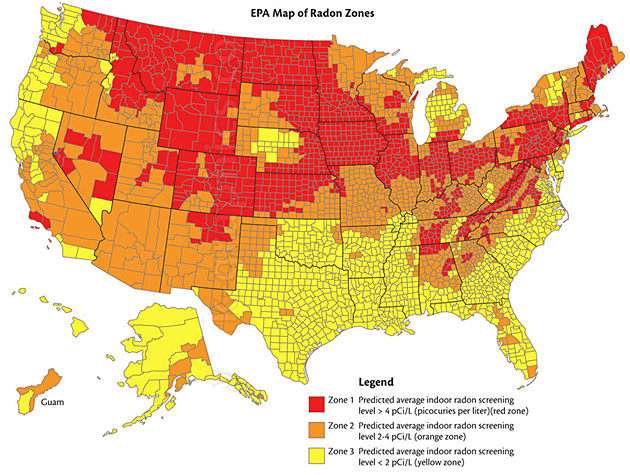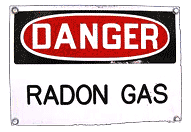|
Radon
Testing
Radon is an invisible, odorless radioactive killer.
It is attributed to causing over 20,000 cases each year of lung
cancer. It is found in outdoor air and in indoor air. It is more
likely concentrated in homes that are built below ground level.

Radon Zones in the United States
Having testing done on acceptable radon levels can save you from
health risks and disease. High levels of radon can be addressed
and steps taken to reduce the levels.
What is Radon?
Radon is a gas that is produced from the decomposition of uranium
or radium that is present in most all soil types. Radon, while
naturally occurring, can be deadly. It is something that you can
detect with the help from a kit from a home improvement or hardware
store.
Radon seeps up from the soil into the air outdoors and indoors.
When you have a home that is located underground you are much
more likely to get deadly seepage in through the walls and floors
of your home. Your home can act like a catalyst for the radon
to collect and build up over time becoming a deadly component
of your indoor air.
It is also possible for radon to enter the indoor space through
well water. It can seep in through your faucets, drains and pipes.
So, in effect, underground homes that use well water especially
need to be tested for radon. Some deep wells may need to be adequately
ventilated or even capped if this is the case. If concerned then
hiring an experience radon consultant may be warranted.
Health Risks
There are serious health risks that are associated with higher
than normal levels of radon in indoor air. One of the most serious
risks is developing lung cancer in both smokers and non-smokers.
Radon is a known carcinogen.

The EPA strongly recommends that you have your home tested
especially if it is an underground home. Houses with basements
are also vulnerable.
As a matter of fact to minimize health risks the EPA recommends
that every home is tested. If you have had your home tested and
plan on moving your sleeping quarters or living space to a lower
level in your home like your basement than you should test it
again.
Acceptable Levels
The acceptable levels are described in one of two ways. Picocuries
Per Litre or Working Levels are usually the way Radon is reported.
The pc/l and w/l acceptable levels are less than 4 for pc/l and
lower than .016 wl. If after testing the levels are higher than
those acceptable levels than the home or building should be repaired.
The short answer to Radon testing in underground homes a necessity
is YES! If you are buying, building or selling an underground
home you need to test for Radon levels.
What to do
There are a couple of different methods that can be undertaken
to minimize the amount of radon gas in one's underground or earth-sheltered
home.
First, using a granular backfill, waterproofing and adequate
drainage will help keep radon outside the home and give it a pathway
to the surface of the soil outdoors where it can dissipate in
the surrounding air. Second, indoor ventilation is a must in which
the air is turned over every one to two hours. Both methods should
be used in combination to minimize risk.
External Links
EPA U. S. Radon map
http://www.epa.gov/radon/zonemap.html
Fix My House
http://www.cdph.ca.gov/HealthInfo/environhealth/Pages/RadonFix.aspx
|

